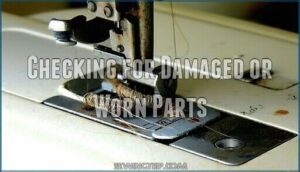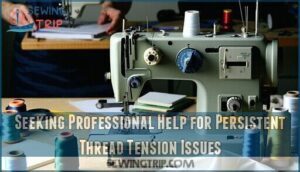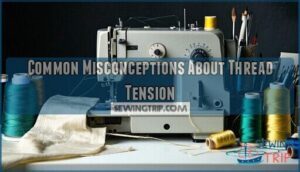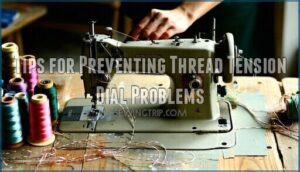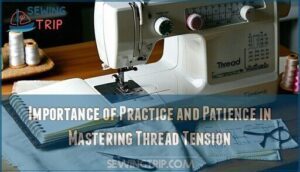This site is supported by our readers. We may earn a commission, at no cost to you, if you purchase through links.

If your dial feels sticky or unresponsive, it’s likely packed with lint that’s preventing smooth operation. Check your needle condition too—a dull or bent needle creates uneven thread flow that no amount of tension adjustment can fix.
The solution often involves methodical testing and proper maintenance rather than random dial spinning.
Table Of Contents
- Key Takeaways
- Common Thread Tension Issues
- Checking and Adjusting Thread Tension
- Potential Problems With The Thread Tension Dial
- Cleaning and Maintaining The Thread Tension Mechanism
- Troubleshooting Thread Tension Dial Problems
- Seeking Professional Help for Persistent Thread Tension Issues
- Common Misconceptions About Thread Tension
- Tips for Preventing Thread Tension Dial Problems
- Importance of Practice and Patience in Mastering Thread Tension
- Frequently Asked Questions (FAQs)
- Conclusion
Key Takeaways
- Start with proper cleaning and maintenance – Most thread tension dial problems stem from lint buildup around the tension discs, so you’ll need to clean debris regularly and lubricate the mechanism to keep it running smoothly.
- Test your settings systematically on scrap fabric – Don’t guess at tension adjustments; instead, test different dial settings on fabric scraps that match your project material to find what actually works.
- Check your needle condition before adjusting tension – A dull or bent needle disrupts thread flow and makes tension adjustments ineffective, so replace worn needles before tweaking your dial settings.
- Make gradual adjustments and document what works – Don’t spin the dial randomly; instead, make small quarter-turn changes and keep notes on successful settings for different fabric and thread combinations.
Common Thread Tension Issues
Your thread tension dial controls how tightly your machine grips the thread as it forms stitches. When this mechanism fails, you’ll notice loose loops, fabric puckering, uneven stitches, or constant thread breaks that can turn any sewing project into a frustrating battle.
Loose Stitches
Loose stitches plague every sewist’s journey, but they’re fixable with proper tension control. When your thread tension dial sits too low, you’ll see messy loops on your fabric’s underside that scream "amateur hour."
Here’s your troubleshooting checklist for better stitch quality:
- Check that your thread passes through all tension discs properly
- Test different thread tension dial settings on fabric scraps first
- Verify that your thread balance matches your fabric choice
- Confirm your sewing technique includes correct presser foot pressure
- Clean lint buildup around tension discs that affects thread breakage
Start by increasing your tension dial setting gradually. Most fabrics work well between settings 3-5, but heavyweight materials need higher tension for proper thread control.
Puckering
Puckering happens when your fabric bunches up like an accordion along the seam line. This annoying issue stems from improper Tension Adjustment and poor Fabric Selection choices that disrupt Stitch Formation.
Here’s your Pucker Prevention game plan:
- Test Thread Quality on scrap fabric before starting your project
- Gradually adjust your thread tension dial up or down in small increments
- Check bobbin threading and consider bobbin tension tweaks
- Match needle size to fabric weight for ideal stitch quality
- Verify correct thread tension issues aren’t masking thread breakage problems
Uneven Stitches
Stitch imbalance shows up as irregular patterns that make your project look unprofessional. Your thread tension dial might not be the only culprit here.
Several factors work together to create uneven stitches:
- Fabric stretch affects how threads lay during sewing
- Thread quality variations cause inconsistent tension control
- Sewing speed changes impact stitch formation
- Needle condition directly influences thread flow
Start by testing your tension settings on scrap fabric. Adjust the thread tension dial gradually while maintaining a steady sewing speed. Poor stitch quality often results from combining multiple issues rather than just one problem.
Breaking Thread
Thread snapping mid-stitch can turn your sewing session into a real headache. When your thread breaks repeatedly, you’re likely dealing with tension imbalance that creates fracture points where fibers can’t handle the stress.
Thread breaks spell disaster faster than you can say seam ripper
Thread Fraying happens when your tension dial settings create excessive pull on delicate fibers. Fiber Breakage occurs at weak spots where yarn snapping becomes inevitable.
Here’s what’s causing your thread tension problems:
- Check your thread tension dial – settings above 6 often cause thread breaks
- Inspect for debris buildup around tension disks that creates uneven pressure
- Test bobbin tension by dropping the bobbin case – it should unroll smoothly
- Replace old or cheap thread that’s more prone to yarn snapping under normal tension
Most thread tension issues stem from dirty mechanisms or incorrect dial calibration, not the thread itself.
Checking and Adjusting Thread Tension
Before you start adjusting your thread tension dial, you need to understand what you’re working with and how to test it properly. Your tension dial controls how tightly the thread flows through your machine, and testing on scrap fabric will show you exactly what needs fixing.
Understanding The Thread Tension Dial
Your machine’s tension dial controls thread flow through metal disks that squeeze or release based on your settings. Most machines use numbers 0-9, though some vary by manufacturer. When you turn the dial clockwise, you increase tension. Turn it counterclockwise to decrease tension.
| Setting Range | Thread Type | Fabric Weight |
|---|---|---|
| 0-2 | Heavy thread | Thick fabrics |
| 3-5 | All-purpose | Medium fabrics |
| 6-9 | Fine thread | Lightweight fabrics |
| Variable | Specialty | Stretch materials |
The dial should move smoothly between settings. If it feels stuck or jumpy, debris has likely built up inside the tension disk maintenance area. Your thread must pass correctly through the disks for proper dial calibration tips to work effectively.
Testing Thread Tension on Scrap Fabric
Before you thread your first stitch, grab some scrap fabric that matches your project material. This simple step prevents costly mistakes on your finished piece.
- Fabric Selection: Use identical fabric type and grain direction as your main project
- Thread Weights: Test with the same thread and needle combination you’ll actually use
- Stitch Balance: Sew several inches, checking both sides for even interlocking
- Tension Gauges: Make small adjustments to the thread tension dial between tests
- Calibration Checks: Document successful settings for future reference on similar materials
Perfect stitches hide the thread tension adjustment process completely beneath smooth, flat seams. Understanding thread tester tools is vital for achieving ideal thread tension.
Adjusting Tension for Different Fabrics and Threads
Once you’ve tested your settings, fine-tune your tension adjustment techniques based on what you’re sewing. Lightweight fabrics like silk need lower tension settings, while heavy denim requires higher numbers on your thread tension dial.
Thread weight factors play a big role too – thick threads need looser settings than fine ones. Material thickness considerations matter just as much.
When adjusting tension dial settings, remember that balanced tension creates even stitches. Most thread tension issues stem from mismatched settings, so match your dial to your project for better results.
Potential Problems With The Thread Tension Dial
Your thread tension dial can develop several frustrating problems that turn smooth sewing into a headache. When the dial gets stuck, becomes unresponsive, or gives inaccurate readings, you’re dealing with common mechanical issues that have straightforward solutions.
Stiff or Difficult to Turn Dial
When your thread tension dial feels like it’s stuck in molasses, you’re dealing with accumulated debris or worn internal components. This common issue affects dial calibration and prevents proper tension dial settings adjustments.
Picture these telltale signs:
- Grinding resistance when turning the dial, like forcing a rusty bolt
- Jerky movement that skips between settings instead of smooth shifts
- Complete lockup where the dial won’t budge despite gentle pressure
Start troubleshooting with tension disk cleaning using compressed air to blast out lint buildup. Next, try dial lubrication with sewing machine oil on pivot points.
If stuck dial repair seems beyond basic debris removal, professional servicing prevents further damage to delicate tension mechanisms.
Inaccurate Tension Settings
When your tension dial settings don’t match your actual stitch quality, you’re dealing with tension calibration issues that can derail any project. This mismatch between dial accuracy and stitch balance creates frustrating thread tension issues.
Here’s your systematic approach to dial accuracy problems:
- Test tension calibration – Sew identical stitches at different tension dial settings using contrasting threads to verify if adjustments actually change stitch quality.
- Check setting guidelines – Compare your machine’s tension setting against manufacturer specifications, as some dials lose calibration over time.
- Monitor thread monitoring consistency – Run multiple test samples at the same setting to confirm that your adjusting thread tension produces repeatable results across different fabrics.
Dial Not Responsive to Adjustments
Your Thread Tension Dial becomes unresponsive when debris clogs the mechanism or calibration shifts. You’ll notice adjustments don’t affect stitch quality, making tension dial settings meaningless.
Common causes include:
- Lint accumulation blocking internal components
- Oil residue creating sticky dial movement
- Worn tension disk surfaces losing grip
- Misaligned calibration from heavy use
- Thread fragments jamming adjustment mechanism
Start with debris removal around the dial area. Thread tension dial problems often resolve with thorough cleaning. Try tension disk cleaning using fabric scraps to floss between disks. If the stuck dial fix doesn’t work, dial calibration may need professional attention. Regular maintenance schedules prevent most adjustment issues. Proper thread tension adjustment is vital to avoid these common problems and guarantee smooth sewing operations.
Cleaning and Maintaining The Thread Tension Mechanism
Your thread tension mechanism needs regular cleaning to prevent lint buildup that causes dial problems. Start by removing accumulated debris from the tension disks, then lubricate according to your machine’s manual and inspect for worn components.
Removing Lint and Debris
Built-up lint acts like a roadblock in your thread tension dial’s smooth operation. Start your Debris Removal process by turning off your machine and removing the needle plate. Use compressed air or a small brush for thorough Lint Cleaning around tension discs. Thread Clearance improves when you carefully extract trapped fibers with tweezers.
Regular Dial Maintenance prevents costly repairs. Fabric Preparation reduces future lint accumulation. This essential Sewing Machine Maintenance step restores your Thread Tension Dial to peak performance through systematic Cleaning Sewing Machine procedures.
Lubricating The Tension Discs
After clearing away lint and debris, proper lubrication keeps your tension disks running smoothly. Apply one drop of sewing machine oil between the tension disks using a precision oiler. Avoid household oils – they’ll gum up your mechanism. Run clean thread through several times to distribute the lubricant evenly.
This simple oil application prevents friction buildup and maintains consistent tension adjustment across all your sewing projects. Regular use of sewing machine oil is essential for maintaining your machine’s overall health.
Checking for Damaged or Worn Parts
Nobody wants their tension dial to fail mid-project. Regular part inspection helps prevent frustrating thread tension issues before they derail your sewing.
Start by examining these critical components for wear patterns and damage:
- Worn Disk Detection: Look for scratched or grooved tension disks that can’t grip thread properly
- Part Inspection: Check tension springs for rust, cracks, or loss of elasticity
- Damage Assessment: Examine dial calibration check marks for alignment issues
- Tension Disk Wear: Feel for rough spots or burrs on disk surfaces
When you spot problems during your damage assessment, don’t attempt DIY repairs on precision components. Professional service guarantees your thread tension dial settings remain accurate and your machine performs reliably.
Troubleshooting Thread Tension Dial Problems
When your thread tension dial isn’t cooperating, the problem often lies beyond the dial itself. Start by checking these three critical components that directly affect how your tension system reacts to dial adjustments.
Checking Needle Condition and Size
Your sewing machine needle is often the hidden culprit behind thread tension dial problems. A dull or bent needle disrupts thread flow, making your tension adjustments ineffective.
Check needle sharpness by running your finger along the tip—any roughness means it’s time to replace it. Needle material matters too; cheap needles break down faster.
Match needle sizing to your fabric weight and thread compatibility. Fine fabrics need size 60/8 needles, while heavy materials require 100/16 or larger. Wrong needle sizing causes 60% of tension-related stitch defects.
Using High-quality Thread
The wrong thread can sabotage even perfectly calibrated thread tension control systems. Quality thread selection prevents common frustrations that plague sewers everywhere.
Consider these thread quality factors that directly impact your upper thread performance:
- Fiber Quality: Premium threads won’t shed lint that clogs tension disks
- Yarn Weight: Consistent thickness ensures smooth thread tension dial response
- Thread Texture: Smooth surfaces reduce friction and prevent binding
Material compatibility matters too. Match your thread selection to fabric type for superior results. High-quality thread eliminates many thread tension issues before they start. Using the right high quality thread is vital for achieving consistent stitch quality.
Inspecting The Bobbin and Bobbin Case
Beyond thread quality, your bobbin and bobbin case hold the key to balanced stitches. Remove the bobbin case and inspect for lint buildup or scratches that disrupt smooth thread flow. Check bobbin placement—it should sit flush without wobbling. The bobbin case needs to be cleaned regularly to avoid thread tension issues.
| Issue | Solution |
|---|---|
| Loose bobbin thread tension | Adjust tension screw clockwise slightly |
| Thread bunching under fabric | Clean case thoroughly, check bobbin alignment |
| Uneven stitch formation | Test bobbin thread pull—should require gentle tug |
Seeking Professional Help for Persistent Thread Tension Issues
Sometimes you’ve tried every fix and your tension dial still acts up like a stubborn teenager. When basic troubleshooting fails and your machine keeps producing wonky stitches despite your best efforts, it’s time to call in the pros.
Consulting a Sewing Machine Technician
When home troubleshooting hits a wall, professional servicing becomes your next move. Certified technicians bring 1-2 years of specialized training and factory-standard diagnostic tools to evaluate your machine’s tension assembly thoroughly.
Here’s what to expect during professional servicing:
- Technician Fees range from $60-$150 per visit, with warranty machines often covered
- Machine Inspection reveals hidden problems like worn springs or internal misalignment in 80% of persistent cases
- Repair Options include genuine manufacturer parts and precision recalibration using test instruments
- Maintenance Schedules recommend professional cleaning every 1-2 years for frequent users
- Diagnostic Tools identify mechanical issues beyond user adjustment capabilities
Professional Sewing Machine Troubleshooting tackles computerized machine adjustments and mechanical machine adjustments that home fixes can’t reach. Sewing Machine Repair specialists use compressed air and specialized solvents to clean inaccessible areas, restoring original stitch quality in over 90% of serviced cases.
Explaining The Specific Dial Problem
When describing your thread tension dial problems to a technician, be specific about the symptoms you’ve observed.
Tell them if your tension dial settings don’t match actual stitch results, indicating dial calibration issues. Mention if you’re experiencing tension imbalance despite proper threading.
Report a stuck dial that won’t turn smoothly or dial wear affecting responsiveness.
Describe any debris removal attempts you’ve tried and exactly how the thread tension dial problems manifest in your stitching.
Getting a Thorough Machine Inspection
Sometimes the solution isn’t in your hands—it’s in the skilled hands of a professional technician. When thread tension dial problems persist despite your best efforts, a thorough machine inspection becomes essential.
A qualified sewing machine technician brings specialized knowledge and diagnostic tools that can identify issues you might miss. They’ll examine every component systematically, from the tension disk cleaning to dial calibration accuracy.
- Complete tension troubleshooting assessment covering both upper and bobbin tension systems
- Detailed servicing schedules recommendation based on your machine’s age and usage patterns
- Precision dial calibration using professional gauges to guarantee accurate tension dial settings
- Comprehensive maintenance routines customized to your specific sewing machine model
Professional machine inspection tips include bringing fabric samples that show your tension problems and explaining exactly when issues occur during machine threading.
Common Misconceptions About Thread Tension
You’ve probably blamed your thread tension dial for every sewing problem that’s ever crossed your machine. The truth is that tension issues often mask other problems like dull needles, poor-quality thread, or incorrect threading that have nothing to do with your dial settings.
Blaming Thread Tension for All Sewing Issues
When your stitches look terrible, you might immediately blame the thread tension dial. But thread tension issues aren’t always the culprit behind sewing problems. Poor sewing machine calibration, wrong thread weight factors, or fabric type considerations can create similar symptoms.
Before adjusting tension settings, check your needle condition and machine threading. Test tension balance techniques using contrasting threads on scrap fabric.
Remember that sewing speed impacts stitch formation too, so slow down and troubleshoot systematically.
Overlooking Other Possible Causes of Problems
Tunnel vision can sabotage your troubleshooting efforts when you assume thread tension causes every sewing problem. Before adjusting that dial again, investigate these potential culprits that masquerade as tension problems:
- Debris Buildup around feed dogs or needle plate blocking smooth fabric movement
- Incorrect Threading path through guides, creating false tension imbalance readings
- Machine Calibration drift affecting timing between needle and bobbin mechanisms
- Fabric Selection mismatches with needle size causing skipped stitches
Smart troubleshooting means checking these basics first. Regular maintenance also involves understanding thread tension basics to avoid common sewing issues.
Understanding The Role of Tension in Sewing
Thread tension isn’t just about turning a dial—it’s the foundation of quality stitching. Your thread tension dial controls how tightly the upper and lower threads lock together during stitch formation.
When you understand thread balance and fabric tension mechanics, you’ll recognize that proper tension control creates even stitches without puckering or loose loops. Master these sewing principles for consistent results.
Tips for Preventing Thread Tension Dial Problems
Prevention beats repairs in terms of thread tension dial problems. Simple maintenance habits can save you hours of frustration and keep your machine running smoothly for years.
Regularly Cleaning and Maintaining The Machine
Why does your thread tension dial act up just when you need perfect stitches? Regular cleaning and maintenance keep your machine running smoothly and prevent costly repairs.
- Tension disk cleaning removes lint buildup that blocks proper thread flow
- Regular lubrication keeps dial movements smooth and responsive
- Preventive maintenance catches problems before they affect your sewing projects
Schedule machine servicing every six months for ideal dial calibration and performance.
Using The Correct Thread and Needle for The Fabric
Matching your fabric selection with appropriate thread types and needle sizes prevents most tension dial headaches. Use size 70/10 needles with cotton thread for lightweight fabrics, while denim demands 90/14 needles and sturdy polyester. This material compatibility creates tension balance naturally.
High-quality thread reduces lint buildup that clogs your thread path, and proper metallic threads prevent thread twisting that confuses your dial’s settings. Proper metallic threads prevent thread twisting that confuses your dial’s settings.
Avoiding Excessive Tension Adjustments
Often, the biggest tension headaches come from constantly fiddling with your dial settings. Smart sewers know that patience beats panic every time.
- Start with factory settings – Your machine’s default tension dial settings work for most projects
- Make micro-adjustments only – Turn the dial just one number at a time for proper tension control
- Test before committing – Always check stitch regulation on scrap fabric before starting your main project
- Document successful settings – Keep notes on tension dial settings that work for specific fabric compatibility combinations
- Reset when stuck – Return to neutral position if you’ve lost track of your dial calibration adjustments
Remember, thread monitoring isn’t about precision on the first try. Small changes prevent tension imbalance issues that lead to bigger problems down the road. Understanding proper threading techniques is vital for achieving ideal thread tension.
Importance of Practice and Patience in Mastering Thread Tension
Mastering thread tension takes time and experimentation – there’s no magic formula that works for every fabric and thread combination. You’ll need to test different settings on scraps before starting each project, keeping notes on what works best for specific materials.
Experimenting With Different Tension Settings
Smart experimentation beats random dial spinning every time. **Start with scrap fabric that matches your project material exactly.
Make quarter-turn adjustments to your tension dial, testing each change before moving further.
Use contrasting thread colors in your needle and bobbin to spot stitch balance issues instantly.
**
**Heavy fabrics like denim need higher tension settings for proper thread control, while delicate materials require gentler dial calibration.
** Watch how your fabric reacts to each thread tension adjustment. Lower numbers loosen tension, higher numbers tighten it.
This methodical approach to adjusting tension dial settings prevents frustration and wasted materials.
Keeping a Record of Successful Adjustments
Smart sewers know that documenting your thread tension dial victories pays off big time. Create adjustment tracking sheets that record your tension dial settings for each fabric type. Note which adjustments solved specific problems and build detailed fabric profiles over time.
Your tension logs become your personal troubleshooting bible. Track stitch monitoring results alongside adjustment patterns to spot what actually works for your machine. Detailed fabric profiles ensure you’re always prepared for any sewing challenge.
Recognizing That Thread Tension May Vary With Each Project
Building on your successful adjustments log, you’ll quickly discover that every sewing adventure brings unique tension challenges. Different fabric types and thread weights demand specific tension balancing approaches.
Your thread tension dial settings won’t stay constant across projects:
- Lightweight fabrics require gentler tension than heavy denim
- Metallic threads need looser settings than cotton varieties
- Decorative stitches often demand different tension than straight seams
Smart project planning means testing tension adjustments on scraps first, preventing thread tension problems mid-project.
Frequently Asked Questions (FAQs)
How do I know if my thread tension dial is not working properly?
Like a compass pointing off magnetic north, your stitches will reveal tension dial issues. Look for loose, loopy top threads or tight puckering in fabric.
The dial might feel stuck or jump settings unexpectedly when you turn it.
Can I use the same tension setting for all types of fabrics?
No, you can’t use the same tension setting for all fabrics. Different materials require different tension adjustments – lighter fabrics need lower settings, while heavier fabrics need higher tension for proper stitch formation.
Can I replace a broken thread tension dial myself?
Thread tension dial replacement isn’t recommended for DIY repair. These components require precise calibration and proper alignment with internal mechanisms.
Contact a professional sewing machine technician for safe, effective replacement and adjustment.
What causes thread tension dial numbers to fade?
Years of constant rubbing from your fingers literally erases the printed numbers on tension dials. Frequent adjustments, oils from skin contact, and cleaning solvents gradually wear away the surface markings, making settings nearly impossible to read.
How often should tension dials be professionally serviced?
Professional servicing every 12-18 months keeps your tension dial running smoothly. Heavy users or those working with specialty threads might need annual maintenance to prevent sticky dials and calibration drift.
Are aftermarket tension dials compatible with my machine?
Compatibility depends on your machine’s specific model and manufacturer. Most aftermarket dials won’t fit properly or function correctly. Check your manual for approved replacement parts or contact the manufacturer directly.
Why does my tension dial skip certain numbers?
Your dial’s likely skipping numbers because debris, lint, or worn components are preventing smooth rotation.
Clean around the dial area and check for accumulated thread bits that block proper alignment between settings.
Conclusion
Mastering thread tension dial problems is like tuning a guitar—each adjustment brings you closer to perfect harmony. You’ve now got nine proven fixes that tackle everything from lint buildup to worn needles.
**Remember, most thread tension dial problems resolve with systematic cleaning and methodical testing rather than random adjustments.
** Don’t skip the basics: clean your tension discs, check your needle condition, and test on scrap fabric before starting your project.
With patience and these troubleshooting steps, you’ll achieve **consistent, professional-looking stitches every time.
**







